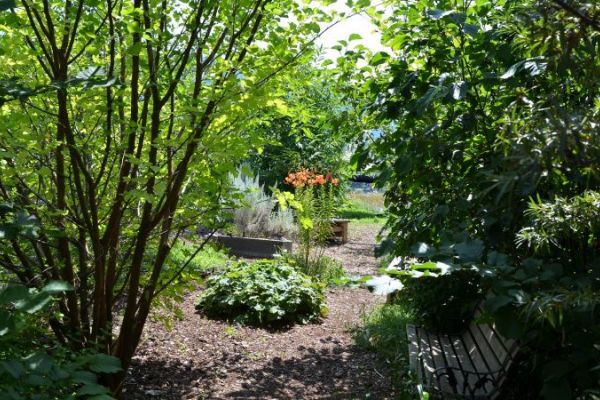History of the Vernon Indigenous Garden

The following story is being shared from Castanet. The story was submitted by the Community Engagement Co-ordinator with the Greater Vernon Museum and Archives.
The K’nma?ka? S?nqâ?t?n Garden is located at the Vernon campus of Okanagan College, on the traditional and unceded territories of the Syilx Nation.
The garden’s creation was a collaboration between the Okanagan Indian Band, the College, and the Food Action Society of the North Okanagan, and showcases traditional Syilx plants, medicine, foods and C’aptikwl.
The first plants added to the garden in 2017-18 were harvested with permission from Elder Theresa Dennis, and came from the Similkameen territory, the Silver Star Mountain Area, and the Head of the Lake.
Native plants such as bitter root, Saskatoon, wild huckleberry, soap berry and balsamroot came to rest in garden beds made from recycled materials and containing locally transplanted soil.
Historically, the Syilx people subsisted on many of these plants, supplemented by wild fish, game and fowl. This system of food sovereignty is by no means a past one, as many Indigenous people in the Okanagan and around the world still maintain a traditional diet instead of consuming only store-bought food.
Studies have found a traditional diet is vitally important to the health of Indigenous individuals. In 2018, the University of Alberta interviewed 265 Syilx adults to reveal the consumption of traditional foods, even in small amounts, led to significantly higher intakes of vital nutrients like protein, omega-3 fatty acids, dietary fibre, magnesium, potassium, riboflavin and vitamins B6, B12, D, and E.
Moreover, the study also determined a traditional diet was extremely important for spiritual, cultural, social, psychological, and economic well-being. All of this likely comes as no surprise to those who follow a traditional diet today.
The historic transition by Indigenous peoples to a Western diet was an act of survival in the face of multiple colonial policies that reduced access to traditional foods and contributed to ecosystem change; the impacts of this forced change continue to be seen today in the health disparities of Indigenous communities across the country.
Places like the K’nma?ka? S?nqâ?t?n Garden provide visitors with an introduction to the roots, fruits, and vegetables that compose a traditional diet, as well as a greater appreciation for the connection Syilx People share with their ancestral territory.
Want to know more about the garden? Check out the link below for more histories.
Tags: Indigenization, Vernon, Inside OC, Truth and Reconciliation





